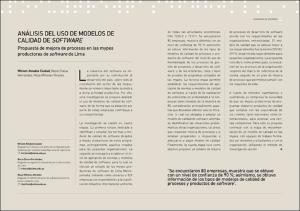| dc.contributor.author | Dorin, Michael | |
| dc.contributor.author | Montenegro, Sergio | |
| dc.date.accessioned | 2018-12-19T14:29:52Z | |
| dc.date.available | 2018-12-19T14:29:52Z | |
| dc.date.issued | 2018 | |
| dc.identifier.citation | Dorin, M., & Montenegro, S. (2018). Designing uncomplicated software. Interfases, (11), 73-86. doi:10.26439/interfases2018.n011.2954 | en |
| dc.identifier.issn | 1993-4912 | |
| dc.identifier.uri | https://hdl.handle.net/20.500.12724/7635 | |
| dc.description.abstract | The Agile Manifesto prescribes less focus on tools and processes, and more focus on human interactions. This is a
very important and powerful concept; however, many development organizations have interpreted it in terms of
no procedures and no processes. This is understandable as many activities, such as the design workflow, are thankless
and laborious. When a proper design is missing, the resulting source code may become overly complicated and
difficult to maintain. The software design does not have to be arduous as this workflow can be done without pain
through an adaptation called Responsibility-Driven Design. This adaptation assigns personalities to the internal
components of the software to humanize the operation. The new design workflow is completely compatible with
agile concepts such as customer interaction, and produces a credible candidate architecture ultimately resulting in
the creation of a less complicated software. | en |
| dc.description.abstract | El Manifiesto Ágil prescribe disminuir el foco en las herramientas y procesos para centrarlo en las interacciones
humanas. Este es un concepto muy importante y potente; sin embargo, muchos equipos de desarrollo lo han traducido
en términos de no procedimientos y no procesos. Esto es comprensible ya que muchas actividades, entre
ellas el flujo de trabajo del diseño, son ingratas y laboriosas. Cuando no se realiza un diseño apropiado, el resultado
puede ser un código demasiado complejo y difícil de mantener. El diseño de un software no tiene que ser arduo y
el flujo de trabajo puede aliviarse con una adaptación denominada “diseño conducido por la responsabilidad” (Responsibility-
Driven Design). Esta adaptación asigna personalidades a los componentes internos del software para
humanizar la tarea. El nuevo flujo de diseño es completamente compatible con los conceptos de agilidad, como
la interacción con el cliente, y produce una arquitectura candidata con credibilidad que resultará en la creación de
un software no complicado. | es |
| dc.format | application/pdf | |
| dc.language.iso | eng | en |
| dc.publisher | Universidad de Lima, Carrera de Ingeniería de Sistemas | es |
| dc.relation.uri | https://revistas.ulima.edu.pe/index.php/Interfases/article/view/2954/3186 | |
| dc.rights | info:eu-repo/semantics/openAccess | * |
| dc.rights.uri | https://creativecommons.org/licenses/by-nc-sa/4.0/ | * |
| dc.source | Universidad de Lima | es_PE |
| dc.source | Repositorio Institucional - Ulima | es_PE |
| dc.subject | Ingeniería del software | es |
| dc.subject | Software-Diseño | es |
| dc.subject | Software engineering | en |
| dc.subject | Computer software-Design | en |
| dc.title | Designing uncomplicated software | en |
| dc.title.alternative | Diseño de software no complicado | es |
| dc.description.peer-review | Revisión por pares | es |
| dc.identifier.journal | Interfases | |
| dc.publisher.country | PE | es |
| dc.type.other | Artículo | |



